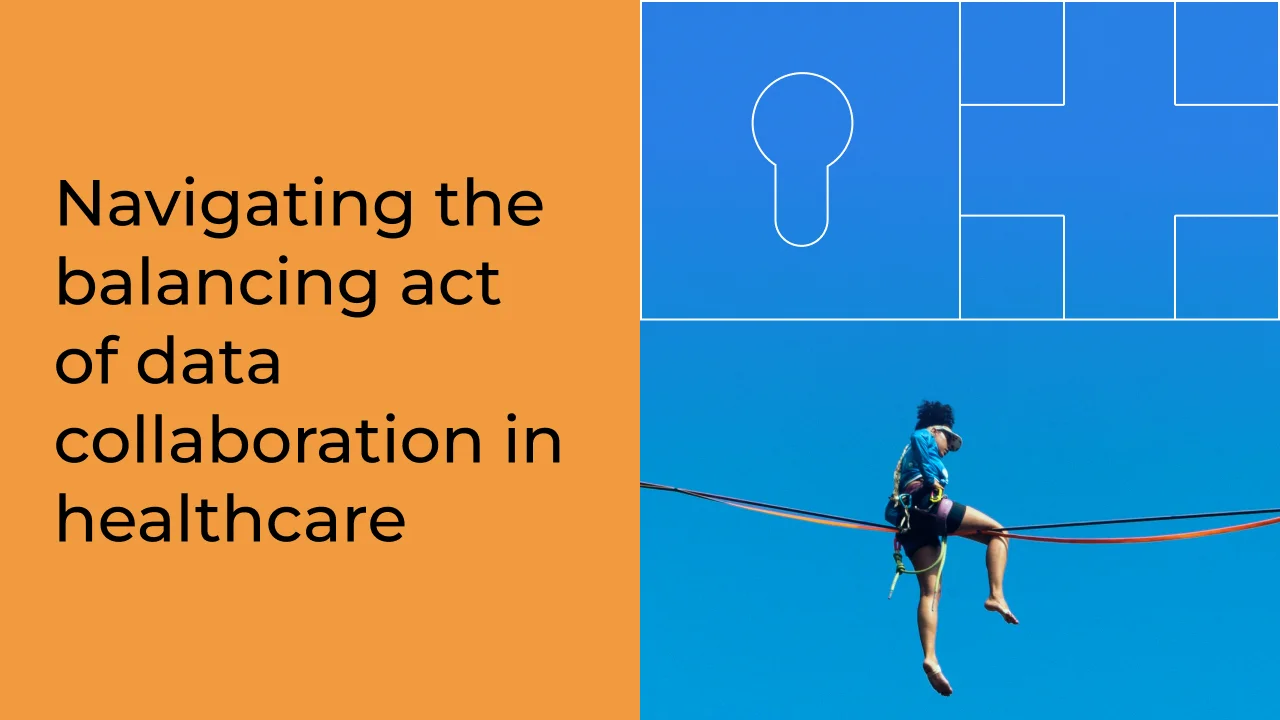
The challenge is clear: how can healthcare organizations unlock insights without exposing sensitive information?
Whitepaper: Unlock the value of real-world healthcare data with confidential data clean rooms
As the amount of healthcare data from real-world settings grows, how can care providers and life sciences companies use this data to advance research and treatment while protecting sensitive patient information?

Healthcare has never had more data — or more barriers to using it. Hospitals, researchers, and life sciences companies recognize that collaboration is essential to improving patient outcomes, but privacy laws and trust concerns often keep data locked in silos.
The challenge is clear: how can healthcare organizations unlock insights without exposing sensitive information?
This article examines the barriers to healthcare data collaboration, the privacy-preserving methods currently available, and why progress and protection don’t have to be a trade-off in the healthcare sector.
Why secure medical data collaboration matters
The true value of healthcare data emerges when it can be combined and analyzed across organizations. Secure medical data collaboration makes this possible, delivering benefits that reach from individual patients to entire health systems.
- For clinicians, richer datasets improve diagnostics and support more personalised care pathways.
- Diverse inputs also enable earlier detection of conditions, reducing the burden of chronic disease.
- For researchers and life sciences companies, secure collaboration accelerates discovery by streamlining clinical trials and enabling real-world healthcare data to inform the development of new treatments.
- For public health, collaborative datasets enable policymakers to track population-level trends, respond quickly to crises, and plan for future needs.
One example of why this matters is the gender health gap: only by pooling diverse datasets can healthcare finally address disparities in how diseases like cardiovascular conditions affect women and men differently.
Global initiatives such as the NHS Secure Data Environments, the European Health Data Space, and Switzerland’s Personalized Health Network demonstrate the momentum behind this shift. The opportunity is clear: collaboration is becoming essential for improving outcomes at every level of care.
The barriers to healthcare data collaboration
If secure collaboration is so valuable, why isn’t it the norm? The answer lies in a set of barriers that have historically made it difficult for healthcare organizations to work together on sensitive data.
Privacy and consent
This is the first challenge. Patient data is among the most sensitive information available, and individuals need to have confidence that their records will not be exposed or misused. Traditional approaches, such as anonymization, reduce risk but also strip away the details that make the data valuable.
Regulation
Frameworks such as GDPR in Europe, HIPAA in the United States, and NHS-specific requirements in the UK impose strict limitations on how data can be stored, transferred, and used. These safeguards are vital, but they make collaboration complex and resource-intensive.
Trust
Trust is often the biggest barrier of all. Hospitals and life sciences companies may want to collaborate, but each fears losing control of its data or exposing intellectual property. This is why data custodianship in healthcare is so important, as it means organizations remain the “guardians” of their data, retaining full control over how it is accessed and used, even when contributing to joint initiatives.
Technical limitations
Tech can hold many projects back. Legacy systems and siloed infrastructures are difficult to integrate, while standard anonymization and de-identification techniques often limit their utility.
Dive deeper into the most significant healthcare data challenges affecting the sector right now.
Methods and strategies for secure healthcare data collaboration
A range of privacy-preserving methods have emerged to help healthcare organizations collaborate without exposing raw data. Each approach comes with its own strengths and limitations, and understanding these trade-offs is essential for choosing the right approach.
Federated learning
Federated learning (FL) decentralises model training. Instead of moving raw patient data to a central location, algorithms are sent to local sites, such as hospitals, where they train on local data. Only the model parameters, not the raw data, are shared back for aggregation.
Strengths: FL allows sensitive data to stay within the organisation that collected it, which helps meet strict regulatory requirements. It has shown promise in areas like radiology and predictive analytics, where models can benefit from diverse datasets without centralising them.
Limitations: FL requires significant on-site compute resources, which can be expensive to maintain. It also restricts the types of analysis that can be performed, making it less suitable for broader research initiatives. Heterogeneous datasets across sites can further reduce the accuracy of aggregated models.
Synthetic data
Synthetic data is artificially generated to mimic the statistical properties of real patient datasets. It allows researchers and developers to work with “safe” versions of sensitive data.
Strengths: Synthetic datasets can be shared more freely, which opens up opportunities for education, early-stage research, and algorithm testing. For instance, synthetic patient records can be used to train AI systems without risking exposure of real patient identities. Read about an example of this here.
Limitations: Accuracy and privacy sit in tension. Highly accurate synthetic data is more useful but also raises the risk of re-identification. Generating synthetic data that balances realism and privacy is technically complex, and combining multiple synthetic datasets can lead to inconsistencies. For large-scale, multi-institutional collaborations, synthetic data is often insufficient to replace real-world datasets.
Confidential computing
Confidential computing addresses one of the hardest problems in healthcare data collaboration: how to protect data while it is being processed. Using trusted execution environments (TEEs), confidential computing keeps data encrypted even while it is in use.
Strengths: This offers the strongest privacy guarantees available today. Sensitive patient information remains protected not only in storage and transit, but also during analysis — even from cloud providers or technology vendors. For healthcare, this aligns naturally with regulations such as GDPR and HIPAA.
Limitations: Implementing confidential computing directly can be technically complex. It requires modern hardware, specialist expertise, and significant changes to existing workflows. That’s why most organizations adopt it through platforms that operationalise the technology. Decentriq’s data clean rooms are built on confidential computing, but remove these barriers — making the technology accessible, collaborative, and compliant out of the box.
Comparing the methods
Each of these approaches brings value but also significant limitations:
- Federated learning is powerful for distributed model training, but its scope is limited.
- Synthetic data broadens access but risks oversimplifying or misrepresenting real-world complexity.
- Confidential computing provides the strongest privacy guarantees but can be difficult for organizations to deploy directly.
What’s missing is a practical framework that brings these privacy-enhancing technologies together in a way that is scalable, compliant, and designed for real-world collaboration.
That’s where data clean rooms come in.
Data clean rooms are the future of medical data collaboration
Data clean rooms are emerging as the most practical solution for secure collaboration on medical data. In simple terms, a data clean room is a secure environment where multiple organizations can combine and analyze data without ever exposing the underlying raw records. Participants gain access to shared insights, but the data itself never leaves the control of its custodian.
Built on confidential computing, data clean rooms leverage the strongest privacy technology available and add the necessary governance, auditability, and collaboration layers to make it usable in real-world healthcare settings. This means hospitals, research institutes, and life sciences companies can collaborate confidently, knowing they remain the custodians of their data at all times.
- For healthcare providers, this custodianship is critical. Sensitive patient information is never revealed, yet organizations can still contribute to larger-scale analyses that improve care pathways or accelerate clinical research.
- For life sciences companies, data clean rooms make it possible to collaborate without exposing proprietary data or intellectual property.
- For regulators, compliance is simplified by built-in controls, audit trails, and standardized rules of engagement.
The result is “sharing without sharing” — a model where collaboration is enabled, but sensitive data remains fully protected. Unlike other approaches, data clean rooms address not only the privacy issue but also the trust and governance concerns that have historically hindered collaboration.
That’s why they are increasingly seen as the future of medical data collaboration: a scalable, secure, and ethically robust way to balance privacy and innovation.
Case study: Over one million cardiovascular patients
Cardiovascular disease (CVD) is the leading cause of death worldwide, yet progress in prevention and treatment depends on access to large, diverse datasets. Traditionally, sharing this kind of sensitive patient information across borders and institutions has been almost impossible, blocked by privacy laws, compliance requirements, and the need for each organisation to retain control of its data.
The iCARE4CVD consortium — comprising Novo Nordisk, Maastricht University, and more than 30 other healthcare organizations — turned to Decentriq to facilitate collaboration. Using Decentriq’s data clean rooms, the consortium was able to securely analyse data from over one million cardiovascular patients across Europe.
Decentriq’s technology ensured that each organisation remained the custodian of its own patient data. Raw records were never taken out of local control, and no one — not even Decentriq — could view them. Instead, only privacy-preserving results were shared.
The outcome was powerful: collaboration that previously would have taken up to 24 months was made possible in just six months. Equally important, partners could connect through secure web interfaces with no change to their existing IT infrastructure.
This case demonstrates how data clean rooms can deliver secure healthcare data collaboration at scale — without compromise.
Governance, trust, and transparency
Even the most advanced technology cannot enable collaboration on its own. For healthcare organizations to work together with confidence, governance and transparency are just as important as encryption and computation.
Effective governance ensures that patient rights and organizational responsibilities are respected at every stage. Clear consent processes, auditability, and standardised protocols make collaboration predictable and accountable. For example, audit trails that show who accessed data, when, and under what conditions are essential for building confidence across multiple stakeholders.
This is where data custodianship in healthcare comes into focus. Hospitals and research institutes must remain the guardians of their data, with complete control over how it is used. Without this assurance, trust breaks down and collaboration stalls.
Data clean rooms simplify governance by embedding these requirements into the technology itself. From consent management to access controls, compliance is designed into the platform. The result is a collaborative environment where privacy is protected, trust is maintained, and innovation can move forward responsibly.
The future of healthcare data collaboration
Healthcare no longer has to choose between protecting patient privacy and driving medical progress. Data clean rooms prove that secure healthcare data collaboration is already possible at scale — enabling hospitals, researchers, and life sciences companies to innovate without compromise. As the demand for trustworthy collaboration grows, data clean rooms will form the foundation of the future of healthcare data.
Discover more about Decentriq’s data clean room solutions for healthcare.
References
Whitepaper: Unlock the value of real-world healthcare data with confidential data clean rooms
As the amount of healthcare data from real-world settings grows, how can care providers and life sciences companies use this data to advance research and treatment while protecting sensitive patient information?

Related content
Subscribe to Decentriq
Stay connected with Decentriq. Receive email notifications about industry news and product updates.

.jpg)


